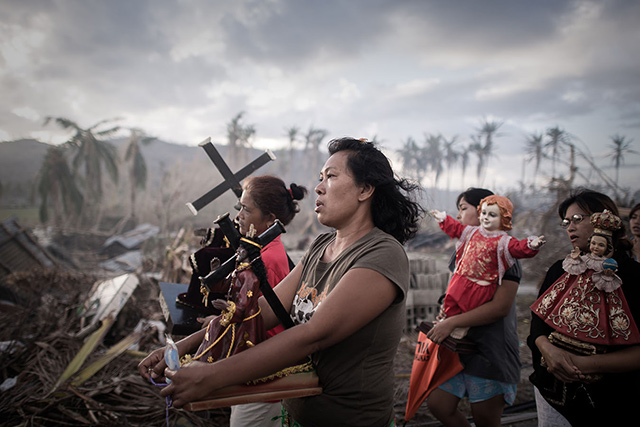Filtered By: Lifestyle
Lifestyle
‘Roofless, not hopeless’: The resilience of Yolanda survivors
By KARL MALAKUNAS, Agence France-Presse

Despite the widespread desperation around them caused by Typhoon Yolanda, residents of Tolosa, Leyte join a procession on Monday, November 18, 10 days after the super typhoon devastated the town and nearby areas. The United Nations estimates that 13 million people were affected by Yolanda with around 1.9 million rendered homeless. AFP/Philippe Lopez
TACLOBAN - A raggedy cloth banner in a town torn apart by one of the most powerful typhoons on record declares that its residents are "roofless, homeless, but not hopeless."
Super typhoon Yolanda left more than 7,500 people dead or missing and ruined the homes of about four million others when it tore across some of the country's poorest fishing and farming communities.
A month after the typhoon struck, the battle for survival remains undeniably desperate in squalid towns, where masses of survivors huddle on roads still choked with debris while waiting for noodles, rice, water or other essentials being handed out by relief workers.
But the hand-painted message on the banner, hanging above a shop front being repaired on the outskirts of the hard-hit port city of Ormoc, represents a spirit of hope and resilience that resonates throughout the disaster zone.
International relief workers, who spend their lives visiting disaster zones around the world, have expressed surprise and admiration at the outwardly jovial determination of the survivors to "bangon," or rise, again.
"People are really struggling and yet the vast majority have got this incredible spirit where they just refuse to be defeated by this disaster," International Federation of the Red Cross spokesman Patrick Fuller told AFP on Friday after visiting some of the worst-hit areas in and around the coastal city of Tacloban.
And while much of the international focus in the immediate aftermath of the typhoon has been on the enormous relief effort that was initially dominated by a giant US military contingent, many survivors have quietly started rebuilding their lives using their own initiative.
In the tiny farming community of Kananga on Leyte island, about 70 kilometers (45 miles) west of Tacloban, virtually all of the coconut trees that have sustained families for generations lie worthless on the ground after being ripped apart by Yolanda's monster winds.
Farmer Pepito Baring and a group of young men were on Friday using a chainsaw in the badly damaged local cemetery to cut coconut trees, which were resting on shattered concrete graves, into planks of timber.
"It takes two trees to get enough wood to rebuild a temporary shelter," Baring, 56, said as he stood bare-chested in the fierce early afternoon sun wearing only a pair of dirty shorts and flimsy rubber sandals.
Along the 100-kilometre road between the devastated towns of Ormoc and Tacloban, there are many similar, improvised saw mills that have spurred an astonishingly fast construction boom, albeit of flimsy homes that would be equally unable to withstand another typhoon.
Countless homes of farming and urban communities have been resurrected using the "coco lumber", as well as the recycled materials of their destroyed houses and sometimes tarpaulin roofing donated by relief organisations.
The number of people listed by the government as homeless has dropped from more than four million shortly after Yolanda struck to just 94,000, with one important factor, the determination of survivors to rebuild their homes themselves using whatever means they can.
Healing Yolanda's wounds to take years
Nevertheless, the poorly rebuilt homes are just band-aids over a gruesome wound that authorities say will take many years and billions of dollars to heal.
Most areas of the central Leyte and Samar islands that were the worst hit by Yolanda remain without electricity and supplies of drinking water.
And nearly three million people remain reliant on life-saving food aid or farming support, such as crop seeds, according to the United Nations.
People living in ruined communities along the sides of major roads on Leyte write messages on boards, such as: "Help us, we need food", in the hope of getting a relief truck to stop.
Yet, desperation should not always be confused for despair.
In one devastated coastal community on the outskirts of Tacloban, hundreds of people queued on Friday for what they said were their first supplies of bottled water for a week.
Among them was Rosalinda Tabao, 55, a mother-of-six who lost her shanty home, her vegetable-stall business and three cousins when Yolanda's tsunami-like storm surges swept across their town.
Tabao said her family lost everything, including all their money and the vegetable crops on a small plot of land they rented and which supplied her vegetable stall.
But Tabao refused to be defeated.
Four days after Yolanda struck, Tabao made a seven-hour bus trip to Ormoc and bought P500 ($12) worth of Chinese cabbage seeds using money donated by her mother-in-law, and sent her husband to plant them on their tiny farm.
"They should be ready in a month," Tabao said as she stood in the queue waiting for water. "Once they are ready, I'll sell them and use the money to buy more seeds, maybe eggplant."
Like her neighbors, Tabao and her husband had also quickly rebuilt a temporary shelter where their old home stood using salvaged materials.
Asked about her strongest emotions over the past month, Tabao said: "I hope. As long as I live, I'll continue to hope." — Agence France-Presse
Tags: yolandaaftermath, typhoonyolanda
More Videos
Most Popular



